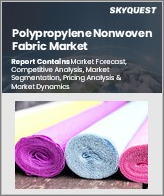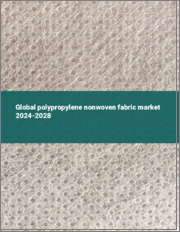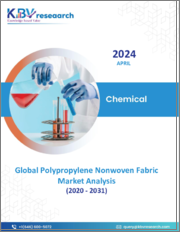
|
시장보고서
상품코드
1734482
세계의 폴리프로필렌 부직포 시장 규모, 점유율, 성장 분석, 제품별, 섬유 유형별, 패브릭 구조별, 재료 유형별, 용도별, 지역별 - 산업 예측(2025-2032년)Polypropylene Nonwoven Fabric Market Size, Share, and Growth Analysis, By Product (Spunbound, Staples), By Fiber Type (Homopolymer, Copolymer), By Fabric Structure, By Material Type, By Application, By Region - Industry Forecast 2025-2032 |
||||||
폴리프로필렌 부직포 세계 시장 규모는 2023년 234억 6,000만 달러로 평가되었고, 예측 기간(2025-2032년)의 CAGR은 4.8%로, 2024년 245억 9,000만 달러에서 2032년에는 357억 7,000만 달러로 성장할 전망입니다.
폴리프로필렌 부직포 시장은 개인 위생에 대한 인식이 높아지고 세계 인구가 증가함에 따라 강력한 성장세를 보이고 있습니다. 특히 신흥국의 일회용 위생용품에 대한 수요가 크고, 그 용도는 헬스케어, 자동차, 농업, 포장에 이르기까지 다양합니다. 폴리프로필렌 부직포는 경량성, 비용 효율성, 우수한 기계적 특성으로 인해 기저귀 및 요실금 제품과 같은 위생 용품에 이상적입니다. 또한, 자동차 분야에서는 자동차 내장재 및 단열재에 사용되고 있습니다. 주목할 만한 트렌드는 소비자의 취향을 충족시키기 위해 바이오 제품 및 재활용 가능한 소재에 투자하여 지속 가능한 관행으로 전환하고 있다는 점입니다. 연구 개발 노력은 혁신적인 생산 방법을 통해 원단 성능 향상에 중점을 두고 있습니다. 아시아태평양은 산업화와 위생 의식에 힘입어 시장을 선도하고 있습니다.
목차
서론
- 조사 목적
- 조사 범위
- 정의
조사 방법
- 정보 조달
- 2차와 1차 데이터 방법
- 시장 규모 예측
- 시장 전제조건과 제한
주요 요약
- 세계 시장 전망
- 공급과 수요 동향 분석
- 부문별 기회 분석
시장 역학과 전망
- 시장 개요
- 시장 규모
- 시장 역학
- 성장 촉진요인과 기회
- 성장 억제요인과 과제
- Porter의 Five Forces 분석
주요 시장 인사이트
- 중요 성공 요인
- 경쟁 정도
- 주요 투자 기회
- 시장 생태계
- 시장의 매력 지수(2024년)
- PESTEL 분석
- 거시경제 지표
- 밸류체인 분석
- 가격 분석
폴리프로필렌 부직포 시장 규모 : 제품별&CAGR(2025-2032)
- 시장 개요
- Spunbound
- Staples
- Meltblown
- Composite
폴리프로필렌 부직포 시장 규모 : 섬유 유형별&CAGR(2025-2032)
- 시장 개요
- 호모폴리머
- 공중합체
폴리프로필렌 부직포 시장 규모 : 패브릭 구조별&CAGR(2025-2032)
- 시장 개요
- 스펀레이스
- 니들 펀치
- 열 접착
- 화학적 결합
폴리프로필렌 부직포 시장 규모 : 재료 유형별&CAGR(2025-2032)
- 시장 개요
- 폴리에스테르
- 폴리프로필렌
- 폴리에틸렌
- 레이온
- 기타
폴리프로필렌 부직포 시장 규모 : 용도별&CAGR(2025-2032)
- 시장 개요
- 위생
- 산업
- 의료
- 지오텍스타일
- 가구
- 카펫
- 농업
- 자동차
- 기타
폴리프로필렌 부직포 시장 규모 : 지역별&CAGR(2025-2032)
- 북미
- 미국
- 캐나다
- 유럽
- 독일
- 스페인
- 프랑스
- 영국
- 이탈리아
- 기타 유럽
- 아시아태평양
- 중국
- 인도
- 일본
- 한국
- 기타 아시아태평양
- 라틴아메리카
- 브라질
- 기타 라틴아메리카
- 중동 및 아프리카
- GCC 국가
- 남아프리카공화국
- 기타 중동 및 아프리카
경쟁 정보
- 주요 5개사 비교
- 주요 기업의 시장 포지셔닝(2024년)
- 주요 시장 기업이 채택한 전략
- 최근 시장 동향
- 기업의 시장 점유율 분석(2024년)
- 주요 기업 개요
- 기업 상세
- 제품 포트폴리오 분석
- 기업 부문별 점유율 분석
- 매출 전년대비 비교(2022-2024년)
주요 기업 개요
- Berry Global, Inc.(USA)
- Key Developments
- Sandler AG(Germany)
- Freudenberg Group(Germany)
- Glen Raven, Inc.(USA)
- Fitesa S.A.(Brazil)
- Pegas Nonwovens a.s.(Czech Republic)
- Lydall, Inc.(USA)
- Fibertex Nonwovens A/S(Denmark)
- Suominen Corporation(Finland)
- Toray Industries, Inc.(Japan)
- Berry Superfos(Denmark)
- Nilit Ltd.(Israel)
- Kimberly-Clark Corporation(USA)
- Low & Bonar Plc(UK)
- Sandler AG(Germany)
- PT. Indo-Rama Synthetics Tbk(Indonesia)
- Glatfelter Corporation(USA)
- Formosa Plastics Corporation(Taiwan)
결론과 제안
LSH 25.06.11Global Polypropylene Nonwoven Fabric Market size was valued at USD 23.46 billion in 2023 and is poised to grow from USD 24.59 billion in 2024 to USD 35.77 billion by 2032, growing at a CAGR of 4.8% during the forecast period (2025-2032).
The polypropylene nonwoven fabric market is experiencing robust growth driven by heightened awareness of personal hygiene and a growing global population. The demand for disposable hygiene products, particularly in emerging economies, is significant, with applications spanning healthcare, automotive, agriculture, and packaging. Polypropylene nonwoven fabrics stand out due to their lightweight nature, cost-effectiveness, and excellent mechanical properties, making them ideal for hygiene items like diapers and incontinence products. Additionally, the automotive sector uses these fabrics for vehicle interiors and insulation. A notable trend is the shift toward sustainable practices, with investments in bio-based products and recyclable materials to meet consumer preferences. R&D efforts focus on enhancing fabric performance through innovative production methods. The Asia-Pacific region leads the market, propelled by industrialization and hygiene awareness.
Top-down and bottom-up approaches were used to estimate and validate the size of the Global Polypropylene Nonwoven Fabric market and to estimate the size of various other dependent submarkets. The research methodology used to estimate the market size includes the following details: The key players in the market were identified through secondary research, and their market shares in the respective regions were determined through primary and secondary research. This entire procedure includes the study of the annual and financial reports of the top market players and extensive interviews for key insights from industry leaders such as CEOs, VPs, directors, and marketing executives. All percentage shares split, and breakdowns were determined using secondary sources and verified through Primary sources. All possible parameters that affect the markets covered in this research study have been accounted for, viewed in extensive detail, verified through primary research, and analyzed to get the final quantitative and qualitative data.
Global Polypropylene Nonwoven Fabric Market Segments Analysis
Global Polypropylene Nonwoven Fabric Market is segmented by Product, Fiber Type, Fabric Structure, Material Type, Application and region. Based on Product, the market is segmented into Spunbound, Staples, Meltblown and Composite. Based on Fiber Type, the market is segmented into Homopolymer and Copolymer. Based on Fabric Structure, the market is segmented into Spunlace, Needle-punched, Thermally bonded and Chemically bonded. Based on Material Type, the market is segmented into Polyester, Polypropylene, Polyethylene, Rayon and Others. Based on Application, the market is segmented into Hygiene, Industrial, Medical, Geotextiles, Furnishings, Carpet, Agriculture, Automotive and Others. Based on region, the market is segmented into North America, Europe, Asia Pacific, Latin America and Middle East & Africa.
Driver of the Global Polypropylene Nonwoven Fabric Market
The growth of the global polypropylene nonwoven fabric market is significantly driven by the rising demand for hygiene and medical products. With a rapidly expanding population and heightened health consciousness, there is an increasing need for various disposable items such as diapers, feminine hygiene products, surgical masks, and medical gowns. Furthermore, the ongoing development of healthcare infrastructure is contributing to this demand. As the preferences for sanitary products continue to evolve, the market is experiencing a notable boost, ensuring a robust trajectory for polypropylene nonwoven fabrics in addressing the essential needs of hygiene and medical applications.
Restraints in the Global Polypropylene Nonwoven Fabric Market
The global polypropylene nonwoven fabric market is significantly hindered by stringent environmental regulations and growing concerns regarding plastic waste. Governments worldwide are advocating for biodegradable alternatives and implementing stricter waste management policies, which in turn increases production costs for manufacturers. This shift towards sustainable materials not only challenges the current market dynamics but also restricts the adoption of traditional polypropylene-based fabrics. Consequently, companies in this sector must navigate these regulatory hurdles while exploring innovative solutions to meet both consumer demand and environmental standards, ultimately impacting their operational strategies and market growth.
Market Trends of the Global Polypropylene Nonwoven Fabric Market
The global polypropylene nonwoven fabric market is experiencing a significant shift towards sustainability, driven by stringent environmental regulations and heightened consumer awareness of ecological issues. This trend is prompting manufacturers to invest heavily in the development of biodegradable and recyclable nonwoven materials, particularly within hygiene and medical sectors. As industries increasingly prioritize environmentally-friendly practices and embrace circular economy principles, the demand for eco-conscious nonwoven solutions is on the rise. Companies are actively seeking to adopt green production methods, aiming to replace traditional polypropylene-based fabrics with sustainable alternatives. This momentum is anticipated to accelerate, solidifying sustainability as a key market driver moving forward.
Table of Contents
Introduction
- Objectives of the Study
- Scope of the Report
- Definitions
Research Methodology
- Information Procurement
- Secondary & Primary Data Methods
- Market Size Estimation
- Market Assumptions & Limitations
Executive Summary
- Global Market Outlook
- Supply & Demand Trend Analysis
- Segmental Opportunity Analysis
Market Dynamics & Outlook
- Market Overview
- Market Size
- Market Dynamics
- Drivers & Opportunities
- Restraints & Challenges
- Porters Analysis
- Competitive rivalry
- Threat of substitute
- Bargaining power of buyers
- Threat of new entrants
- Bargaining power of suppliers
Key Market Insights
- Key Success Factors
- Degree of Competition
- Top Investment Pockets
- Market Ecosystem
- Market Attractiveness Index, 2024
- PESTEL Analysis
- Macro-Economic Indicators
- Value Chain Analysis
- Pricing Analysis
Global Polypropylene Nonwoven Fabric Market Size by Product & CAGR (2025-2032)
- Market Overview
- Spunbound
- Staples
- Meltblown
- Composite
Global Polypropylene Nonwoven Fabric Market Size by Fiber Type & CAGR (2025-2032)
- Market Overview
- Homopolymer
- Copolymer
Global Polypropylene Nonwoven Fabric Market Size by Fabric Structure & CAGR (2025-2032)
- Market Overview
- Spunlace
- Needle-punched
- Thermally bonded
- Chemically bonded
Global Polypropylene Nonwoven Fabric Market Size by Material Type & CAGR (2025-2032)
- Market Overview
- Polyester
- Polypropylene
- Polyethylene
- Rayon
- Others
Global Polypropylene Nonwoven Fabric Market Size by Application & CAGR (2025-2032)
- Market Overview
- Hygiene
- Industrial
- Medical
- Geotextiles
- Furnishings
- Carpet
- Agriculture
- Automotive
- Others
Global Polypropylene Nonwoven Fabric Market Size & CAGR (2025-2032)
- North America (Product, Fiber Type, Fabric Structure, Material Type, Application)
- US
- Canada
- Europe (Product, Fiber Type, Fabric Structure, Material Type, Application)
- Germany
- Spain
- France
- UK
- Italy
- Rest of Europe
- Asia Pacific (Product, Fiber Type, Fabric Structure, Material Type, Application)
- China
- India
- Japan
- South Korea
- Rest of Asia-Pacific
- Latin America (Product, Fiber Type, Fabric Structure, Material Type, Application)
- Brazil
- Rest of Latin America
- Middle East & Africa (Product, Fiber Type, Fabric Structure, Material Type, Application)
- GCC Countries
- South Africa
- Rest of Middle East & Africa
Competitive Intelligence
- Top 5 Player Comparison
- Market Positioning of Key Players, 2024
- Strategies Adopted by Key Market Players
- Recent Developments in the Market
- Company Market Share Analysis, 2024
- Company Profiles of All Key Players
- Company Details
- Product Portfolio Analysis
- Company's Segmental Share Analysis
- Revenue Y-O-Y Comparison (2022-2024)
Key Company Profiles
- Berry Global, Inc. (USA)
- Company Overview
- Business Segment Overview
- Financial Updates
- Key Developments
- Sandler AG (Germany)
- Company Overview
- Business Segment Overview
- Financial Updates
- Key Developments
- Freudenberg Group (Germany)
- Company Overview
- Business Segment Overview
- Financial Updates
- Key Developments
- Glen Raven, Inc. (USA)
- Company Overview
- Business Segment Overview
- Financial Updates
- Key Developments
- Fitesa S.A. (Brazil)
- Company Overview
- Business Segment Overview
- Financial Updates
- Key Developments
- Pegas Nonwovens a.s. (Czech Republic)
- Company Overview
- Business Segment Overview
- Financial Updates
- Key Developments
- Lydall, Inc. (USA)
- Company Overview
- Business Segment Overview
- Financial Updates
- Key Developments
- Fibertex Nonwovens A/S (Denmark)
- Company Overview
- Business Segment Overview
- Financial Updates
- Key Developments
- Suominen Corporation (Finland)
- Company Overview
- Business Segment Overview
- Financial Updates
- Key Developments
- Toray Industries, Inc. (Japan)
- Company Overview
- Business Segment Overview
- Financial Updates
- Key Developments
- Berry Superfos (Denmark)
- Company Overview
- Business Segment Overview
- Financial Updates
- Key Developments
- Nilit Ltd. (Israel)
- Company Overview
- Business Segment Overview
- Financial Updates
- Key Developments
- Kimberly-Clark Corporation (USA)
- Company Overview
- Business Segment Overview
- Financial Updates
- Key Developments
- Low & Bonar Plc (UK)
- Company Overview
- Business Segment Overview
- Financial Updates
- Key Developments
- Sandler AG (Germany)
- Company Overview
- Business Segment Overview
- Financial Updates
- Key Developments
- PT. Indo-Rama Synthetics Tbk (Indonesia)
- Company Overview
- Business Segment Overview
- Financial Updates
- Key Developments
- Glatfelter Corporation (USA)
- Company Overview
- Business Segment Overview
- Financial Updates
- Key Developments
- Formosa Plastics Corporation (Taiwan)
- Company Overview
- Business Segment Overview
- Financial Updates
- Key Developments
















